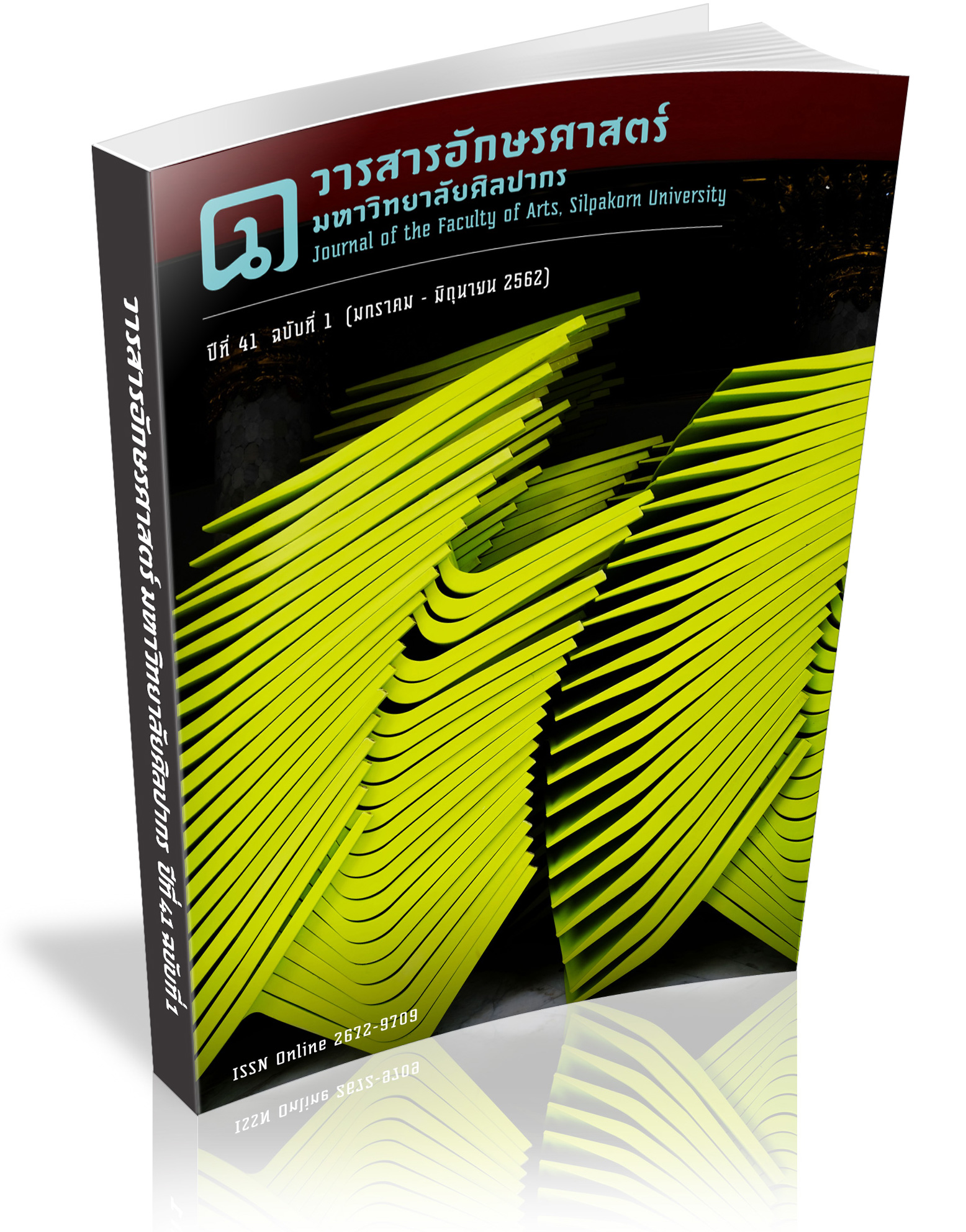Causative connectors in the southern Thai dialect
Historical perspective
Keywords:
Causative connectors, Southern Thai dialect, Language changeAbstract
This article aims to study causative connectors in southern Thai dialect from Ayutthaya period right up until the present. In each period what are some connectors? How did each causative connectors change their function? The data was collected from the southern Thai books and other books from Ayutthaya period right up until the present.
The finding suggest that the causative connectors in southern Thai dialect can be classified into three functions: (1) reason connectors, such as /duaj3/, /phrɔ?7/, /phrɔ?7-wa:6/, /kap3/, /nɯaŋ6-ca:k4/, /bə?3/, /bə:3/, /ka3-bə?3/, /cha:5-thɯŋ1/ and /khɔ:ŋ1/ (2) conditional connectors, such as /tha:1/, /tha:1-lɛː5/, /lɛː5-tha:1/, /tha:1-mɛːn5/, /tha:1-lɛ?7/, /khran5/, /khan5/ and /khan5-tha:1/ (3) purposive connectors are /sam1-rap1/ and /phɯa5/. When considering changes, it is found that causative connectors in southern Thai dialect from Ayutthaya period right up until the present have 2 types of change: (1) a change in number; i.e. (1.1) increase in number (1.2) decrease in number and (1.3) the persistence of number. (2) a change in functions; i.e. appearance of certain causative function, disappearance of causative function and persistence of causative function.
Causative connectors in southern Thai dialect are also interesting in that some causative connectors are used only in southern Thai dialect such as /bə?3/, /bə:3/, /ka3-bə?3/, /chaː5-thɯŋ1/, /khɔ:ŋ1/, /khran5/, /khan5/ and /khan5-tha:1/. The important linguistic mechanisms that motivate the extension of causative connectors are metaphor and metonymy.
Downloads
References
Babdhumedha, D. (1986). Use of conjunctions in the Ratanakosin Period. Masters Dissertation, M.A. in Thai Language, Chulalongkorn University, Thailand. (In Thai)
Bangsan, Ph. (2003). Python reticulatus. Songkhla: The Institute For Southern Thai Studies. (In Thai)
Chanavong, Pr. (2002). Southern Thai Dialect. Nakhon Si Thammarat : Nakhon Si Thammarat Rajabhat University. (In Thai)
Chamniyom, R. (2003). A study of prepositions converted from verbs in Thai. Masters Dissertation, M.A. in Thai Language, Silpakorn University, Thailand. (In Thai)
Chotitearrawong, J. (1981). The usage of conjunctions in the Sukhothai, Ayudhaya and Ratanakosin periods: a comparative study. Masters Dissertation, M.A. (In Thai) Language, Chulalongkorn University, Thailand. (In Thai)
Chusuwan, Khl. (1981). Channa micropeltes is not Channa striatus. Songkhla: The Institute For Southern Thai Studies. (In Thai)
Hopper, P. J. & Traugott, E. C. (2003). Grammaticalization. 2nd ed. United Kingdom: Cambridge University.
Intratat, Ch. (1996). Grammaticalization of verbs into prepositions in Thai. Doctoral Dissertation, Ph.D. in Thai Language, Chulalongkorn University, Thailand. (In Thai)
Klappean, Ph. (2011). The Differences of Grammatical Words used in the Local Southern Dialect of Sathingphra District, Songkhla and those in the Standard Thai. Masters Dissertation, M.A. in Thai Language, Thaksin University, Thailand. (In Thai)
Klinhom, S. (2006). Funny dialogues. Nakhon Si Thammarat: n.p. (In Thai)
Kuryłowicz, J. (1965). ‘L’évolution des Catégories Grammaticales’. Diogenes, 51: 54–71.
Law. (1814). Songkhla: The Institute For Southern Thai Studies. (In Thai)
Law. (1830). Songkhla: The Institute For Southern Thai Studies. (In Thai)
Nuansanong, Kh, ed. (1998). Law of Suratthani 1447. Songkhla: The Institute For Southern Thai Studies. (In Thai)
Paholayuth, N. (1983). The use of prepositions in the Sukhothai, Ayudhya and Ratanakosin periods: a comparative study. Masters Dissertation, M.A. in Thai Language, Chulalongkorn University, Thailand. (In Thai)
Panthumetha, N. (2011). Thai Grammar. 6th ed. Bangkok: Chulalongkorn University. (In Thai)
Panupong, V. (1995). The structure of Thai: grammatical system. Bangkok: Ramkhamhaeng University. (In Thai)
Pharmacopeia of Songkhla. (1789). Songkhla: n.p. (In Thai)
Phiyakul, Ch et al, eds. (2008). Nang Kan Tri. Songkhla: The Institute For Southern Thai Studies. (In Thai)
Phiyakul, Ch, ed. (1995). Nang Lueat Khao. Songkhla: The Institute For Southern Thai Studies. (In Thai)
Phongpaiboon, S, ed. (2548). Traibhum of Ban Krabinoi 1857. Suratthani: Suratthani Rajabhat University. (In Thai)
Pirom, D. (2003). Nai Raeng. Songkhla: The Institute For Southern Thai Studies. (In Thai)
Plan and Policy Analyst. (2006). Pattani Malay-Thai/ Thai - Pattani Malay Dictionary. 2nd ed. Bangkok: S-Print. (In Thai)
Pothipath, V. (2014). The development of connectors in Thai. Bangkok: Chulalongkorn University. (In
Somanawat, M. (1938). Pharmacopeia. Bangkok: Yimsree. (In Thai)
Sanah, N. (2013). Grammaticalization of /dûaj/. Masters Dissertation, M.A. in Thai Language, Chulalongkorn University, Thailand. (In Thai])
Sreewan, P. (2012). National Thai Language Day. Nakhon Si Thammarat : Walailak Abode of Culture. (In Thai)
Sreewan, P. (2005). Southern Thailand. Nakhon Si Thammarat: Walailak Abode of Culture. (In Thai)
Sreewan, P. (2012). Use of health insurance. Nakhon Si Thammarat: Walailak Abode of Culture. (In Thai)
Thonglor, K. (1925-1946). Jaknarin. Songkhla: The Institute For Southern Thai Studies. (In Thai)
Downloads
Published
How to Cite
Issue
Section
License
ผู้เขียนบทความต้องยินยอมในข้อกำหนดต่าง ๆ ของวารสารก่อนส่งบทความตีพิมพ์




